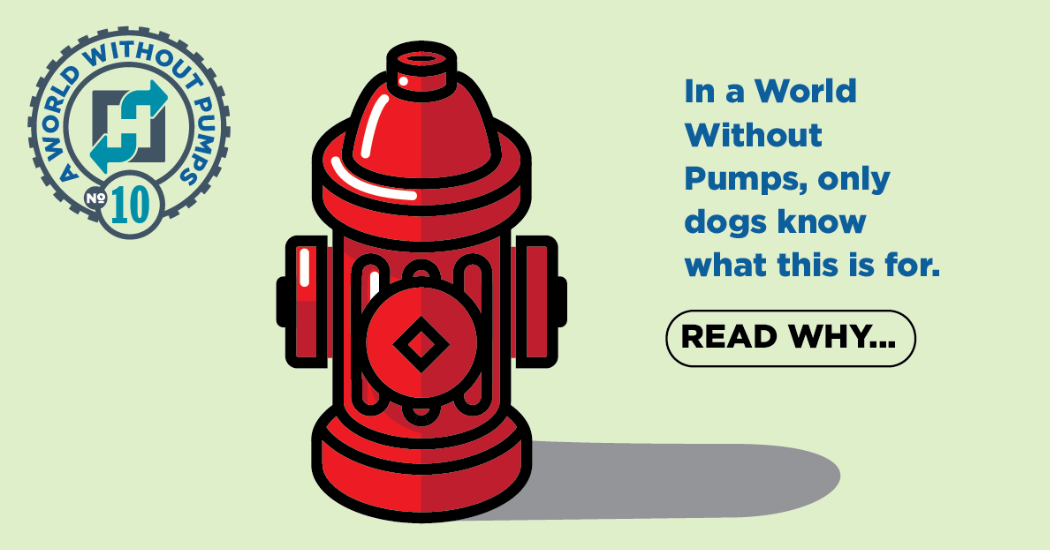The Pressure’s On
In a world with pumps, the pressure is on, and thank goodness. You can count on pumps to create the water to flow when you turn on the tap or flush the toilet, or when the fire department connects to a hydrant. Without pumps, hydrants would barely make a doggie want to use them. Here are some of the ways water pressure makes life easier, safer, and more convenient and provide multiple benefits to people and their communities.
At Home
The obvious convenience of water under pressure in our homes starts with the pumps at the water utility or in our wells. The pressure they provide flushes our toilets and invigorates our showers. Our dishwashers make our meal cleanup easy, thanks to the internal centrifugal pump that increases the water pressure to the sprayers that are attached to rotating arms to clean bowls, utensils, and dishes. When the washing and rinsing are finished, an additional pump propels the water out of the dishwasher into the drain. You couldn’t have a pool, hot tub, fountain or water feature without pumps, as they provide the necessary flow and pressure to keep water circulating.
When you use a pressure washer to clean your patio or garage floor, or maybe your truck or muddy ATV, the pump provides the pressure to do the work. Pressure washers use reciprocating pumps that employ pistons or plungers to add energy to the water and provide the force necessary to clean.
If you live or work in a high-rise building, pumps play an essential role in maintaining water pressure, no matter what floor you’re on. Historically, the only way to get water pressure to the upper floors was to install a rooftop reservoir. Filled by an on/off centrifugal pump connected to the building water supply, it used gravity and other plumbing components to deliver water to the floors located below. Pressure control was a problem. Although this type of system is still used in some older buildings, today, most high-rise buildings use a combination or set of booster pumps, located at different interior levels of the building. Typically, there may be a simplex, duplex or triplex pressure boosting pump system in the basement or at ground level to supply water to the lower floor levels. To provide adequate pressure for the higher floors, a second mechanical room with another booster pump system may be located halfway up the building. This type of system working in series helps maintain a uniform water pressure throughout the building.
Out and About
Wherever you live, pumps keep the pressure up for everything from the fire department to your local car wash. Rotodynamic pumps provide the pressure to move water from wells, reservoirs, lakes, or rivers through processing plants to and within each city’s hotels and restaurants, swimming pools, car washes, food processing plants, offices, and factories. More importantly, pumps provide the controlled pressure and flow to fire hydrants that help keep cities safe.
While pumps play a critical role in traditional firefighting, they are even more important in fighting forest fires and wildfires that often occur in remote areas. Without a ready supply of water, they are essential for filling tanker trucks and aircraft from lakes or streams. Then, at the scene of the fire, they supply the equipment with the necessary pressure and quantity of water to extinguish or control the fire.
In manufacturing plants, high-pressure water jets on waterjet cutting machines cut all types of metal, as well as almost all other materials. It is one of the most productive machining processes and is often preferred over other machining technologies such as flame cutting, plasma cutting, laser machining, and EDM machining, because it doesn’t produce harmful gases or liquids or generate heat. Controlling heat is especially important when working with stainless steel, as extreme heat can alter the material properties. Pumps are at the heart of this truly versatile and efficient cold-cutting process.
Pumps also provide water pressure for mining operations that extract and process minerals and other materials from the earth. They supply the pressure and flow that is necessary for specific applications where water is used for separating, cleaning, washing, cooling, and dust control. Centrifugal pumps of various configurations are the most commonly used pumps for these applications.
Hydraulic mining uses jets of high-pressure water to cut through waste rock or sediments and get to the ore body. This is used frequently in underground coal mining to break up the coal seam and wash away sediments. These processes require pumps that can produce the necessary high pressures.
Some ores, such as coal, are easily pumped through pipelines in a slurry or suspension of water, usually by a centrifugal pump designed with heavy-duty components and features consisting of erosion resistant materials. The same thing applies to waste materials produced after the ore is removed, as pumps are used to transport hazardous waste from mining sites. Other pump designs such as rotary lobe, twin screw or diaphragm types also may be used, depending on the application.
High temperatures are generated in many types of processing operations, and a water bath or spray may be used to cool as needed by either heat transfer or evaporation. Pumps supply the required high volume and pressure of water, which is often pumped away to be recycled and prevent waste.
Heavy-duty operations such as construction, roadbuilding, mining, and agriculture involve equipment that accumulates a considerable amount of dirt and grit over time. To effectively clean this equipment, high-pressure pumps are used to dislodge the dirt and grime from critical or hard-to-reach areas.
Crop irrigation is another area where water pressure plays a key role. Whether by flood irrigation, in which water is distributed to the fields through ditches and contained using dams, or by sprinkler irrigation, in which water is pumped through pipes and distributed by overhead sprinklers, a pump is required to draw the water from a well or natural body and provide the necessary pressure to distribute the water over a large area. Even when you go out for coffee or visit your favorite brew pub, pumps are there to provide the pressure. At your favorite coffee shop, the espresso machines require a rotary vane pump to create the pressures necessary to extract the espresso. When you visit your local brew pub, raise a glass to the pumps that bring you your beer. Breweries from large commercial operations to smaller brew pubs use centrifugal or positive displacement sanitary pumps to move liquids through the beer-making process.
Check out the other World Without Pumps!
Learn more from the Hydraulic Institute.




